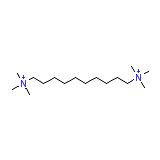Syncurine




Syncurine Brand names, Syncurine Analogs
Syncurine Brand Names Mixture
- No information avaliable
Syncurine Chemical_Formula
C16H38N2
Syncurine RX_link
No information avaliable
Syncurine fda sheet
Syncurine msds (material safety sheet)
Syncurine Synthesis Reference
No information avaliable
Syncurine Molecular Weight
258.486 g/mol
Syncurine Melting Point
268-270 oC
Syncurine H2O Solubility
Substantial
Syncurine State
Solid
Syncurine LogP
No information avaliable
Syncurine Dosage Forms
No information avaliable
Syncurine Indication
For use as a skeletal muscle relaxant
Syncurine Pharmacology
Decamethonium acts as a depolarizing muscle relaxant or neuromuscular blocking agent. It acts as an agonist of nicotinic acetycholine receptors in the motor endplate and causes depolarization. This class of drugs has its effect at the neuromuscular junction by preventing the effects of acetylcholine. Normally, when a nerve stimulus acts to contract a muscle, it releases acetylcholine. The binding of this acetylcholine to receptors causes the muscle to contract. Muscle relaxants play an important role in anesthesia even though they don't provide any pain relief or produce unconsciousness.
Syncurine Absorption
Rapidly absorbed.
Syncurine side effects and Toxicity
LD50=190 mg/kg (orally in mice). Prolonged apnoea, neuromuscular paralysis and cardiac arrest may occur.
Syncurine Patient Information
No information avaliable
Syncurine Organisms Affected
Humans and other mammals














